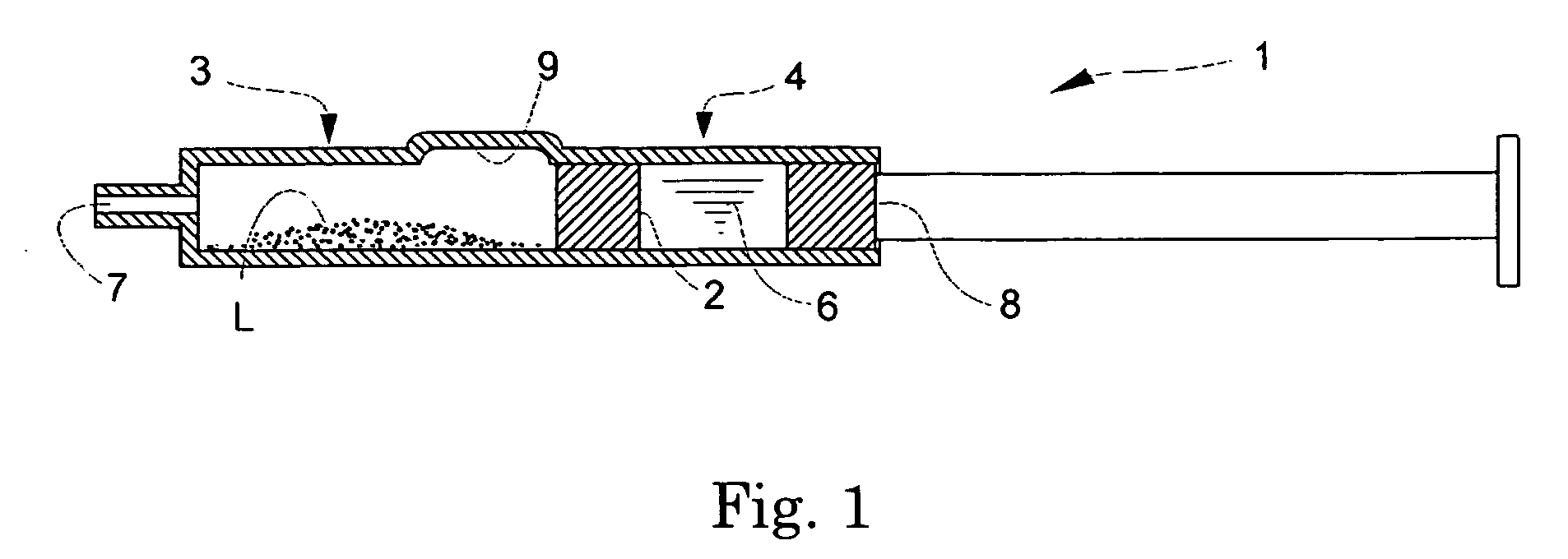Transparent Tissue-Visualizng Preparation
- Summary
- Abstract
- Description
- Claims
- Application Information
AI Technical Summary
Benefits of technology
Problems solved by technology
Method used
Image
Examples
production example 1
Prefilled Vial-Type Transparent Tissue-Visualizing Preparation
[0083] An aqueous solution containing 1.11 w / v % of D-mannitol and 1.11 w / v % of Povidone K-30 was filtered through a hydrophilic filter having the pore size of 0.22 μm to make a solution A. An acetone solution of 10 w / v % of PLA0005 (acetone / ethanol=4 / 6) was prepared and filtered through a hydrophobic filter having the pore size of 0.22 μm to make a solution B. Opeguard MA was made a solution C.
[0084] The solutions A and B were mixed at a proportion of 9:1 in the following manner. Briefly, to the solution A, stirred at 700-800 rpm with a stirrer, was added the solution B, at a rate of about 100 μL / sec, to let PLA0005 precipitate as fine particles. The mixture was stirred for about 30 minutes, and aggregation products were removed through a sieve (mesh size 106 μm) to obtain a suspension D. Lyophilization of this in a vial gave a powder form sample E. Prior to use, the solution C was poured into the vial containing the ...
production example 2
Prefilled Double Chamber Syringe-Type Transparent Tissue-Visualizing Preparation
[0086] An aqueous solution containing 1.11 w / v % of D-mannitol and 1.11 w / v % of Povidone K-30 was filtered through a hydrophilic filter having the pore size of 0.22-μm to make a solution F. On the other hand, a 10 w / v % solution of PLA0005 (acetone / ethanol=4 / 6) was filtered through a hydrophobic filter having the pore size of 0.22 μm to make a solution G. A phosphate buffer (pH 7) containing 0.75% of sodium chloride and 0.16% of potassium chloride was made a liquid H.
[0087] The solutions F and G were mixed at a proportion of 9:1 in the following manner. Briefly, to the solution F, stirred at 700-800 rpm with a stirrer, was added the solution G, at a rate of about 100 μL / sec, to allow PLA0005 to precipitate as fine particles. The mixture was stirred for about 40 minutes (for 10 minutes of which a reduced pressure was applied), and aggregation products were removed through a sieve (mesh size 106 μm) to ...
preparation example 1
Transparent Tissue-Visualizing Preparation Containing Soluble Starch Fine Particles
[0089] A transparent tissue-visualizing preparation of the following formula was prepared in a conventional manner. In the preparation, the average particle size of the soluble starch fine particles was about 50 μm.
Solubile starch1.0 gOpeguard MAto 100 mL
PUM
| Property | Measurement | Unit |
|---|---|---|
| Temperature | aaaaa | aaaaa |
| Mass | aaaaa | aaaaa |
| Size | aaaaa | aaaaa |
Abstract
Description
Claims
Application Information
 Login to View More
Login to View More - R&D
- Intellectual Property
- Life Sciences
- Materials
- Tech Scout
- Unparalleled Data Quality
- Higher Quality Content
- 60% Fewer Hallucinations
Browse by: Latest US Patents, China's latest patents, Technical Efficacy Thesaurus, Application Domain, Technology Topic, Popular Technical Reports.
© 2025 PatSnap. All rights reserved.Legal|Privacy policy|Modern Slavery Act Transparency Statement|Sitemap|About US| Contact US: help@patsnap.com



